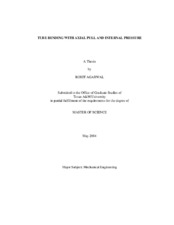| dc.description.abstract | Tube bending is a widely used manufacturing process in the aerospace, automotive, and other industries. During tube bending, considerable in-plane distortion and thickness variation occurs. The thickness increases at the intrados (surface of tube in contact with the die) and it reduces at the extrados (outer surface of the tube). In some cases, when the bend die radius is small, wrinkling occurs at the intrados. In industry a mandrel is used to eliminate wrinkling and reduce distortion. However, in the case of a close bend die radius, use of a mandrel should be avoided as bending with the mandrel increases the thinning of the wall at the extrados, which is undesirable in the manufacturing operation. The present research focuses on additional loadings such as axial force and internal pressure which can be used to achieve better shape control and thickness distribution of the tube. Based on plasticity theories, an analytical model is developed to predict cross section distortion and thickness change of tubes under various loading conditions. Results from both the FEA and analytical model indicated that at the intrados the increase in thickness for bending with internal pressure and bending with combined axial pull and internal pressure was nearly the same. But in the case of bending with the combination of axial pull and internal pressure there was a significant reduction of thickness at the extrados. A parametric study was conducted for the case of bending with combined internal pressure and axial pull and it was seen that with proper selection of the pressure and axial pull wrinkling can be eliminated, thickness distribution around the tube can be optimized, and cross section distortion of the tube can be reduced. Predictions of the analytical model are in good agreement with finite element simulations and published experimental results. The model can be used to evaluate tooling and process design in tube bending. | en |


